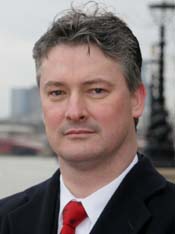News
U.K.'s Cashbox shows promise after public offering
Cashbox's IPO has been well received in the U.K., and the Winchester company now says it has potential to place an additional 5,500 ATMs.
April 18, 2006
Since its announcement to go public in late February, business has been good for Winchester, England's Cashbox ATM Systems Ltd. The independent ATM deployer's trading price on the London Stock Exchange has jumped from 20 pence (U.S. 35 cents) to 35 pence (U.S. 61 cents) since its first day on the AIM market March 29. The share price settled at 31 pence April 11.
(Read also, ATM operator Cashbox expected to join AIM of London Stock Exchange.)
Cashbox is the United Kingdom's third IAD to join the London Stock Exchange's junior market, following Cardpoint Plc. and Scott Tod.
 |
Cashbox founder and CEO Carl Thomas says the U.K. market shows promise. |
Cardpoint, which pulled $107 million (£61.2 million) in sales last year after its acquisition of IAD competitor Moneybox in August, is a dominate player in the marketplace. Scott Tod, which announced 2005 losses of $1.19 million (£680,400) last month, isn't likely to pose any fierce competition. In fact, Cashbox is rumored to be the potential buyer of Scott Tod, one source told ATMmarketplace. (Read also, Scott Tod shares rise after buyout bid.) But The Royal Bank of Scotland Group's Hanco ATM Systems Ltd., TRM Corp. and Travelex all play significant roles in the U.K.'s off-premise market, and they're all competitors with which Cashbox must contend.
Cashbox founder and chief executive Carl Thomas, who formerly worked for Hanco, however, said he's confident his company's public position will fuel growth of between 40 percent and 50 percent over the next 12 months.
Cashbox has already set into motion the installation of 583 new ATM placements, adding to its existing estate of 845 machines. And the company sees potential for the installation of an additional 5,510 ATMs in the near future.
"In the U.K., we are really seeing the market explode," Thomas said. "It's given our model some excitement for the next two or three years."
Market changes are contributing to that excitement. Pubs in the U.K. can now apply for licenses that allow them to operate 24 hours a day, giving independents like Cashbox incentive for more pub placements. And despite the public outcry against surcharging, the U.K.'s ATM market continues to grow. (Read also, Link warns two ATM companies for not complying with fee rules. To read related articles, click here.)
According to the Association for Payment Clearing Solutions, over the last five years, 80 percent of the ATMs deployed in the U.K. have been installed at off-premise locations. Fifty percent of the U.K.'s circulating cash also comes from ATMs, and APACS expects that percentage to hit 75 percent by 2011.
"We see a huge potential for growth," Thomas said. "Surcharging? That issue, essentially, dealt with making these customers aware of surcharging … and what we've found is that the customers that use these machines know that they surcharge, but they know it's a convenience and they're willing to pay a fee."
A market difference
As the market continues to grow, Thomas said, Cashbox's model, based on the company's "lean" corporate structure, will stand out. With a staff of only 22, Cashbox expects 90 percent of its new ATM deals to come from the "placement" model.
Under the placement model, Cashbox retains ownership of the ATM, but the retailer or site owner replenishes the cash and provides connectivity. To replenish the vault, funds are sent electronically through Cashbox on a three-day cycle, saving substantial bank fees, Thomas said.
|
Merchants on the placement model get less from the surcharge, £1.5(U.S. $2.62), but Cashbox is selling convenience.
"We don't ask the merchant to pay anything for the ATM to be placed there," Thomas said. "We're going to our customers and saying you can have all the benefits of the ATM, but we won't ask you to pay for the ATM."
Admittedly, the model will take some time to tweak. The company's network of 845 ATMs, all Tidels (now the Tidel EasyPoint ATMline), includes only 110 on the placement model - a model the company launched in August 2005.
"This is a business model that we believe no other independent ATM deployer focuses on, which has the major benefit of us targeting low footfall areas that our competitors would most likely consider too small," Thomas said. "It also makes the decision for our customers to have an ATM an easy one to make, as there is no capital outlay on their part."









